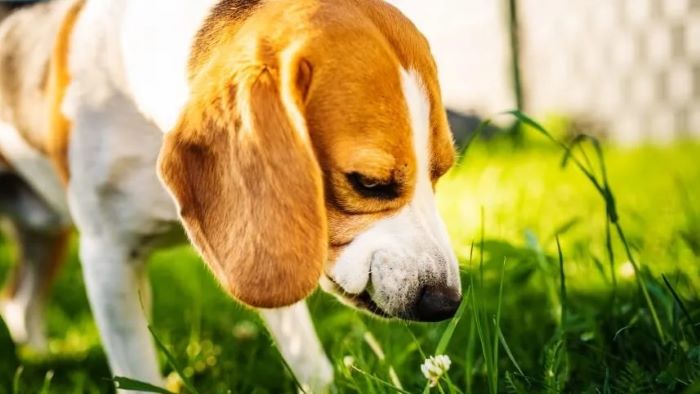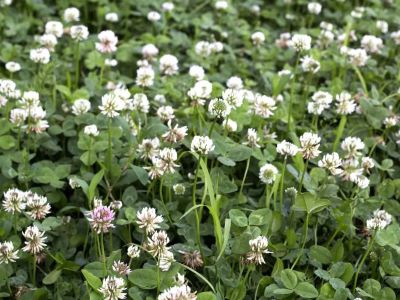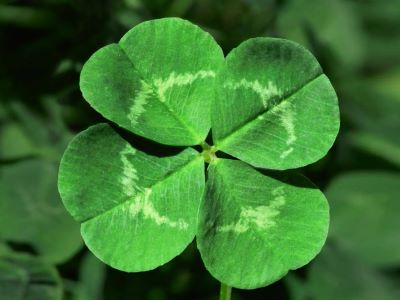It makes sense to ponder what foods our animal friends may and cannot eat when it comes to them. Dogs have a penchant for poking their noses into anything because of their voracious curiosity, including any plants or greens that might grow in your backyard. Clover is one such plant that frequently prompts inquiries.

The lovely flowers and trifoliate leaves of clover are a familiar sight in gardens and on lawns. Even while it may be a necessity for rabbits and other herbivores, many dog owners are left wondering if it is healthy for their pets to consume clover. Are there any advantages to it, or should it be completely avoided?
In this article, we’re going to delve into the world of clover and its relationship with our canine companions.
Table of Contents
What Is Clover?
Generally found in lawns, meadows, and by the sides of roadways, clover is a plant. It is a member of the Trifolium genus, which is home to approximately 300 species of flowering legume plants.
Trifoliate leaves with tiny, red, pink, yellow, or purple flowers make up the clover plant[1]. Because it is high in protein and can fix nitrogen in the soil, clover is often grown as a food crop for animals.
The Different Types of Clover and Their Effects on Dogs
White clover (Trifolium repens), red clover (Trifolium pratense), crimson clover (Trifolium incarnatum), strawberry clover (Trifolium fragiferum), and subterranean clover (Trifolium subterraneum) are the most popular varieties of clover.
There are numerous other varieties as well. Every variety of clover has unique traits and effects on dogs.

White clover
This variety of clover is the most common and well-known. It can get up to 30 cm tall and produces white or pink blossoms. Cyanide, which can be harmful to dogs in excessive amounts, is found in minute amounts in white clover. But dogs usually don’t consume enough white clover to get cyanide poisoning.
In certain dogs, white clover can also result in bloat, gas, and diarrhea.
Red clover
This type of clover has red or purple flowers and reaches a height of 50 cm. Phytoestrogens are plant substances found in red clover that act like estrogen in the body. especially if they are spayed or neutered, phytoestrogens may affect a dog’s hormone balance and reproductive system.
Due to the amount of coumarin, a naturally occurring blood thinner, in red clover, bleeding issues may appear in dogs.
Crimson clover
This variety of clover can reach a height of 60 cm and has beautiful red blossoms. Because it increases soil fertility and reduces erosion, crimson clover is frequently used as a cover crop or green manure.
Since crimson clover doesn’t contain coumarin or cyanide, it is generally safe for dogs to consume. But in certain dogs, it can result in allergic responses like hives, swelling, or itching.
Strawberry clover
This kind of clover can reach a height of 40 cm and has pink blossoms that resemble strawberries. Because strawberry clover can withstand salinity and flooding, it is appropriate for wetlands and coastal locations.
Since strawberry clover doesn’t contain any poisonous ingredients, dogs can consume it without any ill effects. However, it can disrupt certain dogs’ digestive systems, resulting in vomiting or diarrhea.
Subterranean clover
This variety of clover can reach a height of 20 cm and has white or yellow blooms. Because it produces seeds underground, it is challenging to eliminate. Due to its ability to inhibit the growth of other plants, subterranean clover is advantageous for the health of the soil and weed management.
Dogs can consume underground clover without any risk because it doesn’t contain any toxic substances. However, because of its high fiber content, it can cause gas and bloating in some canines.
Is Clover Toxic to Dogs?
Although it is not harmful to dogs per se, eating certain types and quantities of clover can result in some health issues.
Some varieties of clover contain compounds that may affect a dog’s hormones, blood coagulation, metabolism, or oxygen transport. Cyanide, phytoestrogens, coumarin, and mold are a few of these chemicals.

Cyanide
Cyanide is a substance that prevents cells from using oxygen, which leads to cellular asphyxia. Symptoms of cyanide poisoning include weakness, lightheadedness, respiratory problems, seizures, coma, and death.
white clover and a few other plants contain cyanide In minute levels.
Phytoestrogens
Phytoestrogens are substances found in plants that act like estrogen in the body. Particularly if they have been spayed or neutered, phytoestrogens can disrupt a dog’s hormone balance and reproductive system.
Phytoestrogens have been linked to symptoms like infertility, irregular periods, enlargement of the mammary glands, and cancers. Red clover and a few other plants contain significant levels of phytoestrogens.
Coumarin
Coumarin is a natural blood thinner that prevents blood from clotting properly. Coumarin poisoning can cause symptoms such as bleeding gums, nosebleeds, bruising, hemorrhage, or shock.
Coumarin is found in moderate amounts in red clover and some other plants.
Mold
A fungus called mold develops on organic stuff that is decomposing, such as dead plants or animals. Toxins produced by mold may harm a dog’s neurological system, liver, or kidneys.
Symptoms of mold poisoning include tremors, convulsions, nausea, vomiting, diarrhea, jaundice, and organ failure. Any variety of clover can develop mold, especially if it is wet or damaged.
Nutritional Value of Clover for Dogs
Though clover is not a packed or balanced dog food, it might provide some health benefits if consumed in moderation. Protein, fiber, antioxidants, vitamins, and minerals are all plentiful in clover[2].
The quality of the grass and other plants that dogs consume may be improved by clover’s tendency to help the soil fix nitrogen. In addition, clover can help stop weed growth and soil erosion, which will improve the look and health of the lawn.
Some of the nutrients that clover can provide for dogs include:
Protein
For the development and functioning of muscles, bones, skin, hair, and other tissues, protein is crucial. The generation of hormones and the immune system are both regulated by protein.
In order to supplement the animal-based protein that dogs consume from meat or eggs, clover is a useful source of plant-based protein.
Fiber
Fiber is a form of carbohydrate that the body does not digest but helps in the movement of food through the digestive tract. Constipation, diarrhea, obesity, and diabetes in dogs can all be prevented with fiber.
In dogs, fiber may lower cholesterol and blood sugar levels. The fiber found in clover is both soluble and insoluble, which is helpful for the dog’s digestion and metabolism.
Vitamins
Vitamins are organic compounds that are needed in small amounts for various biochemical reactions in the body. Vitamins can help support the immune system, vision, skin health, nerve function, and blood formation in dogs.
Clover is a good source of vitamins A, C, E, K, and B complex, which can provide various benefits for the dog’s health.
Minerals
For some of physiological functions in the body, minerals, which are inorganic elements, are required in small quantities. Minerals can support the health of a dog’s blood cells, muscles, neurons, bones, and teeth.
The health of the dog can benefit from minerals like calcium, iron, magnesium, potassium, zinc, and copper, which are high in clover.
Antioxidants
Free radicals are unstable chemicals that can harm cells and lead to oxidative stress and inflammation in the body. Antioxidants are compounds that help shield cells from this damage. In dogs, antioxidants can aid in the prevention of or assist lower the risk for chronic illnesses like cancer, arthritis, diabetes, and heart disease.
Antioxidants like flavonoids, polyphenols, and carotenoids, which are abundant in clover, have a number of health benefits for dogs.
How to Prevent Your Dog from Eating Clover

Clover is a common plant that grows in many lawns and fields. While it is not poisonous to dogs[3], it may cause some problems if your dog eats too much of it. To prevent your dog from eating clover, you should follow these steps:
- Maintain a weed-free, groomed lawn. Where there is little or no grass, clover frequently grows in patches. You may lessen the chance of clover blooming in your yard by keeping a healthy lawn.
- Keep watch on your dog when you take it for walks. Any clover plants you come across on the way should not be approached by your dog. You can also use a leash or a muzzle to prevent your dog from eating items from the ground.
- Look for any symptoms of clover poisoning in your dog. If your dog ate clover, it might show symptoms like bleeding gums, nosebleeds, bruising, swollen joints, lameness, weakness, or anemia. Take your dog to the vet right away if you observe any of these symptoms.
As mentioned by bechewy, "If you aren’t sure what your pet ate, call the ASPCA’s Animal Poison Control Hotline at 888-426-4435 or the Pet Poison Helpline (855-764-7661). They’re available 24 hours a day, 365 days a year. They can tell you how toxic the plant is and if you need to seek veterinary care."
FAQs
Can puppies eat clover?
To meet their specific nutritional requirements, puppies should eat mostly high-quality puppy food. The ideal course of action is to speak with your veterinarian before introducing any new foods to your puppy’s diet, even though a tiny amount of clover may be safe for them.
How much clover is too much for dogs?
There is no definitive answer to how much clover is too much for dogs, as it depends on the size, weight, age, and health of your dog, as well as the type and quality of the clover. However, as a general rule, you should avoid letting your dog eat large amounts of clover or eat it frequently. A few nibbles here and there may not cause any harm, but a handful or more could be dangerous.
How can I identify clover plants?
Usually low-growing, clover plants contain three oval or heart-shaped leaflets. There may be white dots or marks on the wings. White, pink, red, or purple can be found in the tiny, round flowers of clover. There are clover plants in gardens, roadsides, fields, and meadows.
Can I use clover as a herbal remedy for my dog?
There is not enough evidence to support the safety and effectiveness of clover for dogs. Moreover, clover may interact with some medications or supplements that your dog is taking. Therefore, you should not use clover as a herbal remedy for your dog without consulting your vet first.
What should I do if my dog eats a large amount of clover at once?
If your dog consumes a substantial quantity of clover, monitor them for any signs of digestive upset, such as vomiting or diarrhea. If symptoms persist or worsen, contact your veterinarian.
Conclusion
When used rightly, clover can be a safe and at times advantageous part of your dog’s diet. You may decide whether to let your dog graze on this garden vegetation or just observe it from a distance in your yard by being aware of the potential advantages and risks. Your dog’s health and wellbeing should always come first, and your veterinarian may offer advice that is particular to your pet’s needs.
Reference:
- Trifolium repens (Clover, Dutch Clover, Ladino Clover, Purple Dutch Clover, Shamrock, White Clover) | North Carolina Extension Gardener Plant Toolbox. (n.d.).
- Christina Curell , Michigan State University Extension. (2014). Benefits of white clover as a cover crop. MSU Extension.
- Budd, A. (2022, September 5). These 25+ plants are toxic to pets. CAES Newswire.


